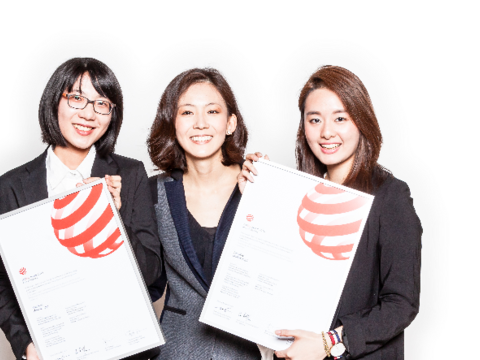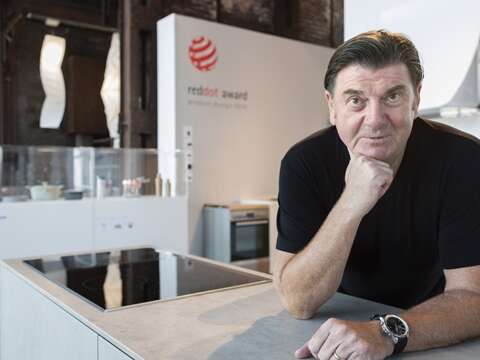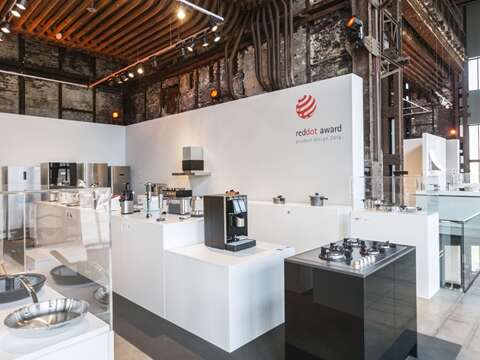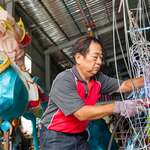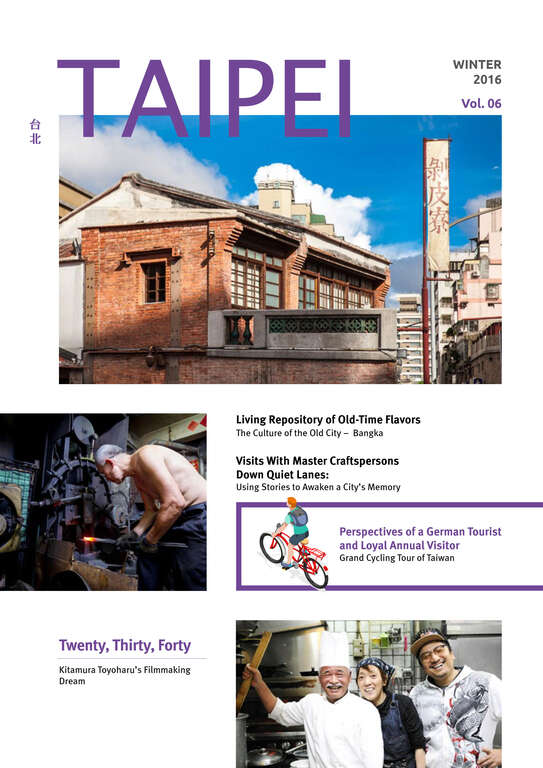Post date:2017-03-10
1584
Surveying Taipei City –Using Design to Improve Life
Red Dot Award CEO Peter Zec
Article_Cai Shutian
Photos_Bernd Lauter, Red Dot Award
The Grim Reaper aimed and then shot at the tires. The blast was ear-splitting. The car spun ferociously like a boomerang, and onlookers gasped. Fortunately, the car owner escaped the clutches of death. Speaking of his recent car accident, the head of the Red Dot Award, Dr. Peter Zec, takes out his mobile phone to show the photos. “If it had happened 50 years ago,” he says, “I would have died! Instead, I stood beside the severely damaged Ferrari smoking a cigar. This is what design means to me – good design and good technology, enhancing convenience and safety, and making life easier.”
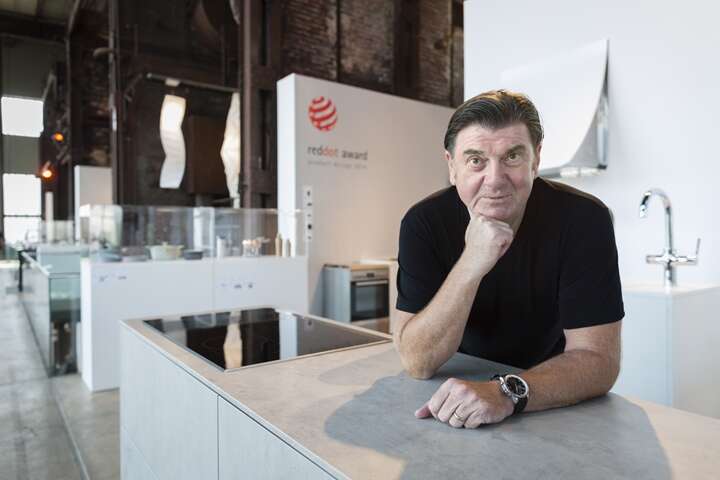
▲ (Photo: Bernd Lauter)
Cultural Hybridization – Internationalization as the Cornerstone of Success
Zec, who is from Germany, has in the past served as president of the International Council of Societies of Industrial Design and chairman of the International Design Alliance. He is also the initiator and CEO of the Red Dot Award, as well as founder of the World Design Capital project. He has dedicated more than 30 years of his life to promoting the design industry and academic research, gaining recognition for industrial and social design, and now in his senior years, utilizing the wisdom and insight he has attained, continues promoting the great enterprise of design restlessly, and serving as a world-class design-industry expert, consultant and advocate.
As the world’s third Red Dot Design Museum is located in Taipei’s Songshan Cultural and Creative Park (松山文創園區), and Taipei was the World Design Capital for 2016, Zec has visited the city on numerous occasions. The city’s cultural constitution and the design of its architectural spaces has left a deep impression on him. “Design and social structure are intimately related,” he says, “and Taiwan’s education and social atmosphere are quite free and open. Taipei is Taiwan’s capital and premier city, and very early on developed extensive linkages with the rest of the world. These are the keys to Taipei’s dynamic design energy.”
Providing a little personal background, Zec says that his father worked for the Germans during the Second World War. Afterwards, he responded to recruitment efforts and became a British soldier, and met and married Zec’s mother. As a result, Zec enjoyed exposure to the cultures and languages of a variety of European regions while growing up, helping him to develop an international perspective.
In the same vein, he has observed how Taipei City has broadened its horizons in recent years, breaking through the barriers of nationality. The best talent from different fields has been concentrated to carry out myriad innovative social design endeavors with an international perspective and focused on achieving the highest quality. The people of Taipei have also become more proactive regarding the imagination, transformation, and implementation of a better society.
Zec believes that Taiwan’s understanding of and demand for design has grown, and he finds the ecology and structure of its design industry intriguing, with so many energetic and dynamic small and medium-sized design firms. Taiwan has also long participated in the Red Dot Design Award competition, its entries increasing year by year and its performance becoming better and better.
“Germany, the United States, England, France, Japan, and other countries have strong national characters,” he says, “and selling goods to these countries is not easy. The same dilemma has been encountered with the Red Dot Award. The way I break through these limitations is to invite international reviewers of different types of experience and background to use multiple evaluation models to review the design of products. In addition, I have staged numerous exhibitions in the United States and Asia, raising awareness of the Red Dot Award. This has been the first step in my success – globalization.” Zec recommends the same model for Taipei in its step-by-step progress toward internationalization. Use ample talent from all fields, and lead all of Taiwan in the use of a macro, diverse perspective to take in the environment in its entirety. This will showcase Taiwan’s design dynamism for all the world to see.
Pragmatic Nature – Good Design Creates Breakthroughs
Free of flattery or hyperbole, Zec has an extremely positive and pragmatic view of design. In his analysis, such things as furniture, home decorations, and tableware are “crafts,” while real design is found in industrial products which brings breakthroughs in daily living, and has the ability to create beneficial economic effects. “New technologies and new materials are the driving forces behind design,” he states. “The task of design is to improve quality of life for people. Designers must think: What sort of contribution do I want to make? How can I change our lives? We should not blindly believe in brands, or celebrity designers. Making a good chair represents, at best, the introduction of another chair. The design of smart phones or smart cars can be a major breakthrough in the development of human society. However, such designers often remain unknown. The focus of the story should be on ‘making our lives more convenient and comfortable.’ The rest is extraneous, just for show!”
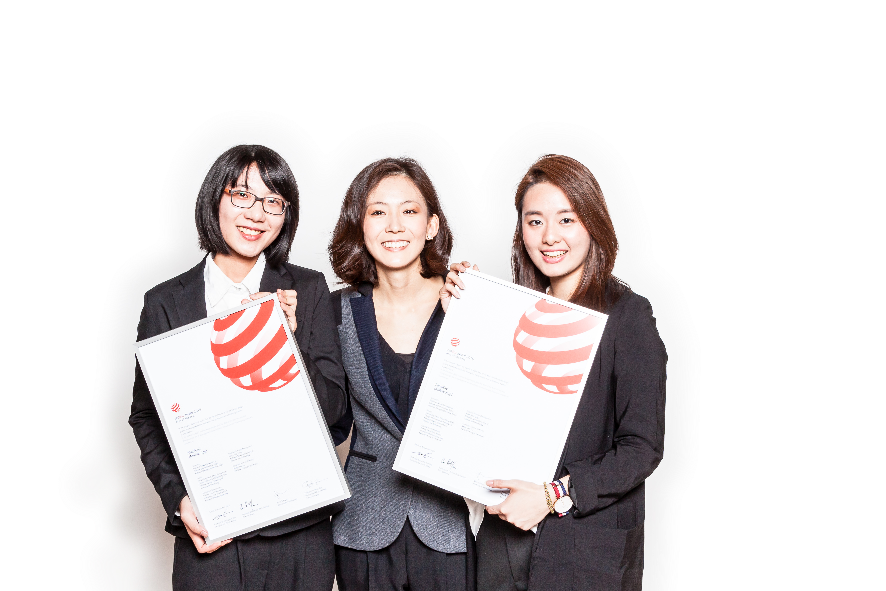
▲ The 2015 Red Dot Award: The Junior Prize went to the cutting-edge design team of Wang I-fang (left), Chen Hsuan-eng (center), Chen Chien- hsing (right), and Lin Yi- ying . (Photo: Red Dot Award)
In the 2015 competition, the Red Dot: Junior Prize went to students Chen Hsuan-eng (陳萱恩) and Chen Chien-hsing (陳潛心) from National Taiwan University of Science and Technology (國立台灣科技大學) and Wang I-fang (王奕方) and Lin Yi-ying (林禕瑩) from National Chengchi University. This team developed BlindNavi, an App that helps the visually impaired to navigate. It imitates the identification methods used by the visually impaired on the streets, which are then integrated with commonly used multi-sensory messages. In this case, design has met a social need. This work demonstrates the strong sense of social responsibility possessed by contemporary designers, who use design to improve quality of life, which deeply impresses Zec.
Over the past few decades, Taipei has comprehensively revived the cityscape. This endeavor has encompassed its intricate transportation system, as well as its medical care and cultural infrastructure, and the sustained transformation has brought continued international attention. The core concept of Taipei as 2016 World Design Capital was Adaptive City – Design in Motion, with social issues a focus of attention and designers addressing the structural problems and individual issues facing society. Designers must have solid understanding of the latest technology, production techniques, and materials processing to satisfy increasingly important social design needs. This reflects the spirit of Zec’s statement “making life more convenient and comfortable.”
Celebrating Glory, Living Life Vigorously
Since the establishment of the Red Dot Award, a website, books, exhibitions, and museums have been created. The next step is to launch a dedicated TV channel. Zec believes that glorifying design heroes, recognizing their value, and opening up more opportunities for award winners are the key tasks in recording and promoting human civilization. This was the purpose in establishing the Red Dot Award. He compares a visit to a Red Dot Design Museum for the design world to a pilgrimage to Mecca for religious devotees. These museums serve as an individual showcase stage for “design heroes” normally hidden from public view. The Red Dot Design Museum in Taipei’s Songshan Cultural and Creative Park is part of the transformation of a historical tobacco-factory complex into a design cluster, and serves as a window on the vigorous development of future Taiwan creative energy. In this regard, his hope is that the Red Dot Design Museum not only enables the Taiwanese to enjoy viewing award-winning works, but also leads to deeper understanding of the stories behind these works.
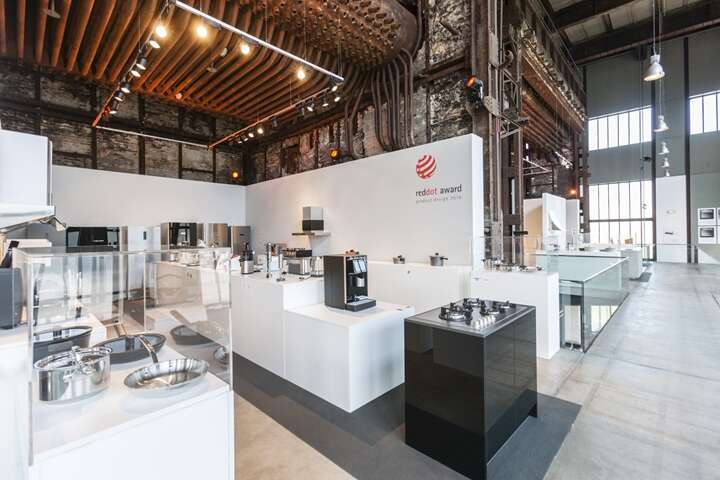
▲ The world’s third Red Dot Design Museum, opened in Taipei’s Songshan Cultural and Creative Park. (Photo: Bernd Lauter)
Harboring no illusions about the future, Zec shares his pragmatic views on life, reminding us that earnestness brings the trust of others and that passion and a sense of responsibility must be the driving forces behind hard work. “I cannot tell you what the day I die will be like,” he says. “I only imagine what it will be like after getting out of bed tomorrow morning, and how I will plan a new day, so that life is more fulfilling. With each new day I discover what small, subtle changes can be made that day.” In the same vein, he looks forward to seeing Taiwan continuing in its passion and sense of responsibility toward the social environment. This attitude will enhance innovative dynamism. A love of science and technology, and the search for the means to make life better, brings with it much fascination!
Red Dot Award
Red Dot Award is one of the world’s three major awards for the design industry, along with the iF Design Awards of Germany and the International Design Excellence Awards (IDEA) of the United States. What is today known as the Red Dot Award competition was established in 1955 by the German design association Design Zentrum Nordrhein Westfalen. Each year, designers from over 60 countries participate, with 10,000 submissions. Winning works are displayed at the Red Dot Design Museum in Essen, Germany, and the designers are invited to attend an awards ceremony.
Red Dot Award CEO Peter Zec
Article_Cai Shutian
Photos_Bernd Lauter, Red Dot Award
The Grim Reaper aimed and then shot at the tires. The blast was ear-splitting. The car spun ferociously like a boomerang, and onlookers gasped. Fortunately, the car owner escaped the clutches of death. Speaking of his recent car accident, the head of the Red Dot Award, Dr. Peter Zec, takes out his mobile phone to show the photos. “If it had happened 50 years ago,” he says, “I would have died! Instead, I stood beside the severely damaged Ferrari smoking a cigar. This is what design means to me – good design and good technology, enhancing convenience and safety, and making life easier.”

▲ (Photo: Bernd Lauter)
Cultural Hybridization – Internationalization as the Cornerstone of Success
Zec, who is from Germany, has in the past served as president of the International Council of Societies of Industrial Design and chairman of the International Design Alliance. He is also the initiator and CEO of the Red Dot Award, as well as founder of the World Design Capital project. He has dedicated more than 30 years of his life to promoting the design industry and academic research, gaining recognition for industrial and social design, and now in his senior years, utilizing the wisdom and insight he has attained, continues promoting the great enterprise of design restlessly, and serving as a world-class design-industry expert, consultant and advocate.
As the world’s third Red Dot Design Museum is located in Taipei’s Songshan Cultural and Creative Park (松山文創園區), and Taipei was the World Design Capital for 2016, Zec has visited the city on numerous occasions. The city’s cultural constitution and the design of its architectural spaces has left a deep impression on him. “Design and social structure are intimately related,” he says, “and Taiwan’s education and social atmosphere are quite free and open. Taipei is Taiwan’s capital and premier city, and very early on developed extensive linkages with the rest of the world. These are the keys to Taipei’s dynamic design energy.”
Providing a little personal background, Zec says that his father worked for the Germans during the Second World War. Afterwards, he responded to recruitment efforts and became a British soldier, and met and married Zec’s mother. As a result, Zec enjoyed exposure to the cultures and languages of a variety of European regions while growing up, helping him to develop an international perspective.
In the same vein, he has observed how Taipei City has broadened its horizons in recent years, breaking through the barriers of nationality. The best talent from different fields has been concentrated to carry out myriad innovative social design endeavors with an international perspective and focused on achieving the highest quality. The people of Taipei have also become more proactive regarding the imagination, transformation, and implementation of a better society.
Zec believes that Taiwan’s understanding of and demand for design has grown, and he finds the ecology and structure of its design industry intriguing, with so many energetic and dynamic small and medium-sized design firms. Taiwan has also long participated in the Red Dot Design Award competition, its entries increasing year by year and its performance becoming better and better.
“Germany, the United States, England, France, Japan, and other countries have strong national characters,” he says, “and selling goods to these countries is not easy. The same dilemma has been encountered with the Red Dot Award. The way I break through these limitations is to invite international reviewers of different types of experience and background to use multiple evaluation models to review the design of products. In addition, I have staged numerous exhibitions in the United States and Asia, raising awareness of the Red Dot Award. This has been the first step in my success – globalization.” Zec recommends the same model for Taipei in its step-by-step progress toward internationalization. Use ample talent from all fields, and lead all of Taiwan in the use of a macro, diverse perspective to take in the environment in its entirety. This will showcase Taiwan’s design dynamism for all the world to see.
Pragmatic Nature – Good Design Creates Breakthroughs
Free of flattery or hyperbole, Zec has an extremely positive and pragmatic view of design. In his analysis, such things as furniture, home decorations, and tableware are “crafts,” while real design is found in industrial products which brings breakthroughs in daily living, and has the ability to create beneficial economic effects. “New technologies and new materials are the driving forces behind design,” he states. “The task of design is to improve quality of life for people. Designers must think: What sort of contribution do I want to make? How can I change our lives? We should not blindly believe in brands, or celebrity designers. Making a good chair represents, at best, the introduction of another chair. The design of smart phones or smart cars can be a major breakthrough in the development of human society. However, such designers often remain unknown. The focus of the story should be on ‘making our lives more convenient and comfortable.’ The rest is extraneous, just for show!”

▲ The 2015 Red Dot Award: The Junior Prize went to the cutting-edge design team of Wang I-fang (left), Chen Hsuan-eng (center), Chen Chien- hsing (right), and Lin Yi- ying . (Photo: Red Dot Award)
In the 2015 competition, the Red Dot: Junior Prize went to students Chen Hsuan-eng (陳萱恩) and Chen Chien-hsing (陳潛心) from National Taiwan University of Science and Technology (國立台灣科技大學) and Wang I-fang (王奕方) and Lin Yi-ying (林禕瑩) from National Chengchi University. This team developed BlindNavi, an App that helps the visually impaired to navigate. It imitates the identification methods used by the visually impaired on the streets, which are then integrated with commonly used multi-sensory messages. In this case, design has met a social need. This work demonstrates the strong sense of social responsibility possessed by contemporary designers, who use design to improve quality of life, which deeply impresses Zec.
Over the past few decades, Taipei has comprehensively revived the cityscape. This endeavor has encompassed its intricate transportation system, as well as its medical care and cultural infrastructure, and the sustained transformation has brought continued international attention. The core concept of Taipei as 2016 World Design Capital was Adaptive City – Design in Motion, with social issues a focus of attention and designers addressing the structural problems and individual issues facing society. Designers must have solid understanding of the latest technology, production techniques, and materials processing to satisfy increasingly important social design needs. This reflects the spirit of Zec’s statement “making life more convenient and comfortable.”
Celebrating Glory, Living Life Vigorously
Since the establishment of the Red Dot Award, a website, books, exhibitions, and museums have been created. The next step is to launch a dedicated TV channel. Zec believes that glorifying design heroes, recognizing their value, and opening up more opportunities for award winners are the key tasks in recording and promoting human civilization. This was the purpose in establishing the Red Dot Award. He compares a visit to a Red Dot Design Museum for the design world to a pilgrimage to Mecca for religious devotees. These museums serve as an individual showcase stage for “design heroes” normally hidden from public view. The Red Dot Design Museum in Taipei’s Songshan Cultural and Creative Park is part of the transformation of a historical tobacco-factory complex into a design cluster, and serves as a window on the vigorous development of future Taiwan creative energy. In this regard, his hope is that the Red Dot Design Museum not only enables the Taiwanese to enjoy viewing award-winning works, but also leads to deeper understanding of the stories behind these works.

▲ The world’s third Red Dot Design Museum, opened in Taipei’s Songshan Cultural and Creative Park. (Photo: Bernd Lauter)
Harboring no illusions about the future, Zec shares his pragmatic views on life, reminding us that earnestness brings the trust of others and that passion and a sense of responsibility must be the driving forces behind hard work. “I cannot tell you what the day I die will be like,” he says. “I only imagine what it will be like after getting out of bed tomorrow morning, and how I will plan a new day, so that life is more fulfilling. With each new day I discover what small, subtle changes can be made that day.” In the same vein, he looks forward to seeing Taiwan continuing in its passion and sense of responsibility toward the social environment. This attitude will enhance innovative dynamism. A love of science and technology, and the search for the means to make life better, brings with it much fascination!
Red Dot Award
Red Dot Award is one of the world’s three major awards for the design industry, along with the iF Design Awards of Germany and the International Design Excellence Awards (IDEA) of the United States. What is today known as the Red Dot Award competition was established in 1955 by the German design association Design Zentrum Nordrhein Westfalen. Each year, designers from over 60 countries participate, with 10,000 submissions. Winning works are displayed at the Red Dot Design Museum in Essen, Germany, and the designers are invited to attend an awards ceremony.
Gallery
:::
Popular articles
 TAIPEI QUARTERLY 2016 WINTER Vol.06
TAIPEI QUARTERLY 2016 WINTER Vol.06 Women’s Volleyball Super-Spiker Wang Sin-Ting (TAIPEI QUARTERLY 2016 WINTER Vol.06)
Women’s Volleyball Super-Spiker Wang Sin-Ting (TAIPEI QUARTERLY 2016 WINTER Vol.06) Paiwan Skating ‘God of War’ Sung Ching-Yang (TAIPEI QUARTERLY 2016 WINTER Vol.06)
Paiwan Skating ‘God of War’ Sung Ching-Yang (TAIPEI QUARTERLY 2016 WINTER Vol.06) A literary World Flow Tour of Taipei-A Look at the Old City’s Elegance (TAIPEI QUARTERLY 2016 WINTER Vol.06)
A literary World Flow Tour of Taipei-A Look at the Old City’s Elegance (TAIPEI QUARTERLY 2016 WINTER Vol.06) The Culture of the Old City – Bangka (TAIPEI QUARTERLY 2016 WINTER Vol.06)
The Culture of the Old City – Bangka (TAIPEI QUARTERLY 2016 WINTER Vol.06) The Rise of Post-Youth Culture and Creativity Arts Pilgrimage – Ximending (TAIPEI QUARTERLY 2016 WINTER Vol.06)
The Rise of Post-Youth Culture and Creativity Arts Pilgrimage – Ximending (TAIPEI QUARTERLY 2016 WINTER Vol.06)
 Red Dot Award CEO Peter Zec (TAIPEI QUARTERLY 2016 WINTER Vol.06)
Red Dot Award CEO Peter Zec (TAIPEI QUARTERLY 2016 WINTER Vol.06)